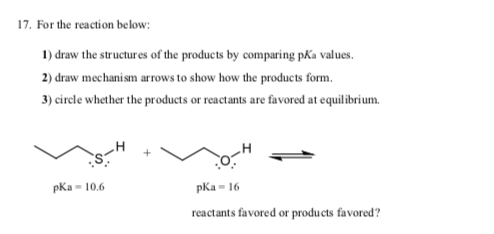17. For the reaction below: 1) draw the structures of the products by comparing pKa values. 2) draw mechanism arrows to show how the products form. 3) circle whether the products or reactants are favored at equilibrium. pKa - 10.6 pka- 16 reactants favored or products favored? 18. The following compound has three nitrogen atoms. In the spaces provided, rank these three nitrogen atoms above in order of increasing base strength (1 = strongest base, 3 = weakest base). H.i H-N.
17. For the reaction below: 1) draw the structures of the products by comparing pKa values. 2) draw mechanism arrows to show how the products form. 3) circle whether the products or reactants are favored at equilibrium. pKa - 10.6 pka- 16 reactants favored or products favored? 18. The following compound has three nitrogen atoms. In the spaces provided, rank these three nitrogen atoms above in order of increasing base strength (1 = strongest base, 3 = weakest base). H.i H-N.
Chemistry
10th Edition
ISBN:9781305957404
Author:Steven S. Zumdahl, Susan A. Zumdahl, Donald J. DeCoste
Publisher:Steven S. Zumdahl, Susan A. Zumdahl, Donald J. DeCoste
Chapter1: Chemical Foundations
Section: Chapter Questions
Problem 1RQ: Define and explain the differences between the following terms. a. law and theory b. theory and...
Related questions
Question

Transcribed Image Text:17. For the reaction below:
1) draw the structures of the products by comparing pKa values.
2) draw mechanism arrows to show how the products form.
3) circle whether the products or reactants are favored at equilibrium.
pKa - 10.6
pka- 16
reactants favored or products favored?

Transcribed Image Text:18. The following compound has three nitrogen atoms. In the spaces provided, rank these three nitrogen atoms
above in order of increasing base strength (1 = strongest base, 3 = weakest base).
H.i
H-N.
Expert Solution
This question has been solved!
Explore an expertly crafted, step-by-step solution for a thorough understanding of key concepts.
This is a popular solution!
Trending now
This is a popular solution!
Step by step
Solved in 2 steps with 2 images

Recommended textbooks for you

Chemistry
Chemistry
ISBN:
9781305957404
Author:
Steven S. Zumdahl, Susan A. Zumdahl, Donald J. DeCoste
Publisher:
Cengage Learning

Chemistry
Chemistry
ISBN:
9781259911156
Author:
Raymond Chang Dr., Jason Overby Professor
Publisher:
McGraw-Hill Education

Principles of Instrumental Analysis
Chemistry
ISBN:
9781305577213
Author:
Douglas A. Skoog, F. James Holler, Stanley R. Crouch
Publisher:
Cengage Learning

Chemistry
Chemistry
ISBN:
9781305957404
Author:
Steven S. Zumdahl, Susan A. Zumdahl, Donald J. DeCoste
Publisher:
Cengage Learning

Chemistry
Chemistry
ISBN:
9781259911156
Author:
Raymond Chang Dr., Jason Overby Professor
Publisher:
McGraw-Hill Education

Principles of Instrumental Analysis
Chemistry
ISBN:
9781305577213
Author:
Douglas A. Skoog, F. James Holler, Stanley R. Crouch
Publisher:
Cengage Learning

Organic Chemistry
Chemistry
ISBN:
9780078021558
Author:
Janice Gorzynski Smith Dr.
Publisher:
McGraw-Hill Education

Chemistry: Principles and Reactions
Chemistry
ISBN:
9781305079373
Author:
William L. Masterton, Cecile N. Hurley
Publisher:
Cengage Learning

Elementary Principles of Chemical Processes, Bind…
Chemistry
ISBN:
9781118431221
Author:
Richard M. Felder, Ronald W. Rousseau, Lisa G. Bullard
Publisher:
WILEY